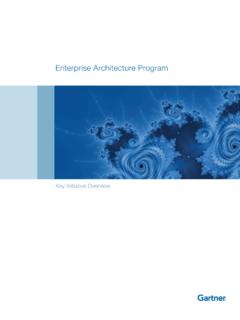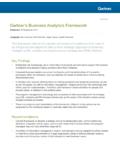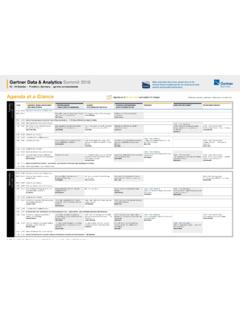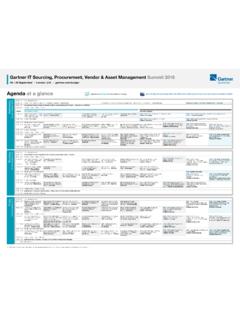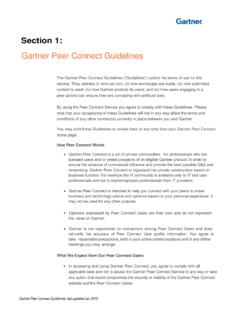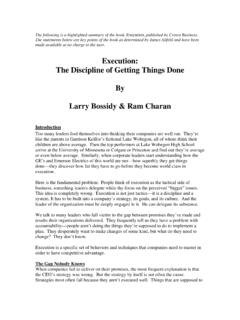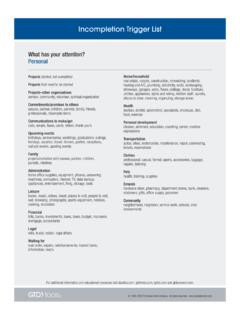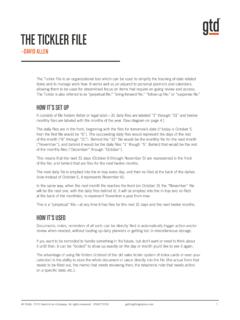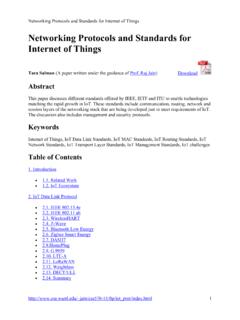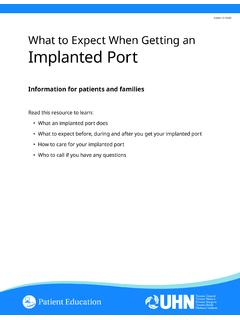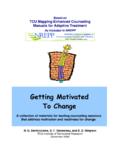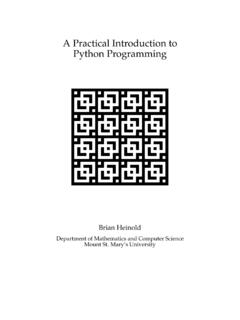Transcription of Leading the IoT - Gartner
1 2017 Gartner , Inc. and/or its affiliates. All rights reserved. Gartner is a registered trademark of Gartner , Inc. or its affiliates. For more information, email or visit BY Mark Hung, Gartner Research Vice PresidentGartner Insights on How to Lead in a Connected WorldLeading the IoTLeading the IoT2 The Internet of things (IoT) has rapidly become one of the most familiar and perhaps most hyped expressions across business and technology. We expect to see 20 billion internet-connected things by 2020. These things are not general-purpose devices, such as smartphones and PCs, but dedicated-function objects, such as vending machines, jet engines, connected cars and a myriad of other IoT will have a great impact on the economy by transforming many enterprises into digital businesses and facilitating new business models, improving efficiency and increasing employee and customer engagement. However, the ways in which enterprises can actualize any benefits will be diverse and, in some cases, Hung Gartner Research Vice PresidentThe biggest barrier to the IoT is that most enterprises do not know what to do with the technology.
2 And if they do have plans for the IoT, there is concern over who will be Leading these initiatives. This need is an opportunity for CIOs to fill that IoT leadership book is intended to be a guide for CIOs and IT leaders who want to take a broader view of the IoT; it provides them with a foundation from which to start business conversations, develop their thinking and refine their approaches to accelerate time to value from IoT initiatives. Leading the IoT3 ContentsLeverage the IoTCHAPTER 104 Secure the IoTCHAPTER 212 Staff the IoTCHAPTER 316 Exploit the IoTCHAPTER 423 Leading the IoT4 Leverage the IoTCHAPTER 1 Leading the IoT5 Commuters and pleasure travelers depend on reliable train service to get where they are going safely and with minimal delays. Train service operators want to provide that reliable service while also optimizing internal costs. Trenitalia, the main Italian service operator, leveraged the IoT in a three-year implementation plan to deliver improved reliability and compelling cost savings.
3 With more than 1,500 train sets running more than 7,000 routes per day, Trenitalia shifted from corrective/reactive activities and maintenance plans to a system that reflects the real conditions of each train s components. Working together with its partner SAP, Trenitalia built a robust set of IoT use cases, associated business benefits and financial models related to optimizing train maintenance, and the team obtained buy-in from key internal stakeholders. These efforts resulted in a clearly defined three-year implementation blueprint for the Dynamic Maintenance Management System (DMMS), which partners with Italian system integrator AlmavivA for IT implementation and SAP for the data platform and leverages onboard and ground-based sensors and diagnostics and sends that data to an on-premises private cloud for analytics in near real time. At the heart of DMMS is the transformation of maintenance from a mix of corrective/reactive activities and maintenance plans based on distance and time, to a system based on life and health indicators that reflect precisely the real physical conditions of each component of the trains.
4 Life indicators typically measure the expected wear of components by counting relevant parameters such as cycles, time, distance and energy. Health indicators measure the actual status of component operation, such as the closing time for a door or the temperature of a cooling the IoTBrake pads, for example, had always been replaced according to standard maintenance plans based on distance (kilometer) intervals. By adding a life indicator that measures the energy dissipation capability of friction braking in real time, Trenitalia now knows that route-specific factors (hills, curves and local routes with many stops), along with kilometers, have a direct bearing on brake pad life. Combined with the addition of new health measures, such as brake pressure and temperature and whether the brake is on a locomotive or a coach, Trenitalia has been able to optimize brake pad utilization and reduce maintenance activities without impacting safety or Internet of things (IoT) is a network of dedicated physical objects ( things ) that contain embedded technology to communicate and sense or interact with their internal states or the external environment.
5 The connecting of assets, processes and personnel enables the capture of data and events from which a company can learn behavior and usage, react with preventive action, or augment or transform business processes. The IoT is a foundational capability for the creation of a digital the IoT6 Although Trenitalia is more than halfway through its three-year implementation plan, many other business and IT leaders are still wondering if the IoT can ever overcome the hype and fulfill its promise in organizational and societal disruption. Initially, leaders viewed the IoT as a silver bullet, a technology that can solve the myriad IT and business problems that their organizations faced. Very quickly, though, they recognized that without the proper framing of the problems, the IoT was essentially a solution looking for a problem, says Mark Hung, research vice president and lead analyst for IoT research. Next, leaders started to explore the applications and use cases for which the IoT is best suited as their organizations embarked on their journeys toward digitalization.
6 Finally, in 2017, we expect some of these explorers to move to the reality phase, when skunkworks projects and proofs of concept graduate to commercial or production deployment. As IoT projects become reality for some organizations, CIOs can leverage lessons from Trenitalia s journey, aligning the IoT to desired business goals, gaining internal support for use cases and driving IoT initiatives with a roadmap and blueprint to create significant the path to IoT business valueThe generality of the term IoT and the wide variety of delivery forms and back-end services can make it difficult to identify how to capture business value. Your first step is to move the conversation from talking about the IoT in general to talking about what it can do, or be, specific to your organization. The IoT can deliver business benefits ranging from operational improvements, such as predictive maintenance, to digital business transformation, such as selling product usage as a service.
7 Initially, leaders viewed the IoT as a silver bullet, a technology that can solve the myriad IT and business problems that their organizations faced. Very quickly, though, they recognized that without the proper framing of the problems, the IoT was essentially a solution looking for a problem. Mark Hung, Gartner Research Vice PresidentLeverage the IoTLeading the IoT7 Do not be shortsighted. Start with a strategic perspective by aligning use case identification with the strategic levers that drive success for your organization. Be sure to balance pragmatism (what is proven to deliver now) with vision (how the IoT can enable transformational business moments), says Chet Geschickter, research director. Move beyond viewing the IoT as a general technology wave by applying an industry lens to identify relevant use cases. Create a basic benefits frameworkThe benefits from the IoT can be internally focused, such as improving your employees safety in a hazardous production environment, or externally oriented, such as improving patient outcomes in an acute care setting.
8 Build a basic benefits framework and organize benefits at a high level according to whether they are primarily internal or external. Move beyond viewing the IoT as a general technology wave by applying an industry lens to identify relevant use cases. Chet Geschickter, Gartner Research DirectorTHE INTERNET OF THINGSINTERNAL BENEFITSEXTERNAL BENEFITSE nhance ServicesImprove Well-BeingGenerate RevenueIncrease EngagementImprove Safety and SecurityOptimize AssetsConserve ResourcesReduce ExpensesLeverage the IoTLeading the IoT8 Organizations should also look at the IoT in conjunction with other technologies, says Geschickter. What happens when the IoT is combined with machine learning, advanced analytics, augmented reality or all of the above? Look at broader bundles of technologies and determine what can be done with those bundles. Combinatorial innovation is a term we use for this. What creative solutions and offerings can you build when you mix multiple transformational technologies together?
9 Ensure that every IoT project has clearly identified business goals and objectivesIt is essential before architecting and implementing any IoT solution that some time be spent to describe the IoT use case and value that your IoT pilot or project will deliver to your enterprise. Leaders in Trenitalia s engineering department its CIO and other early project champions, for example worked together with other functional leadership to gain internal support, including obtaining funding for the initiative from the company s step is critical, as it describes what new functionality, capabilities or differentiation your IoT project will deliver. It links these to the impact on customers, validates what basic benefits you can expect and establishes the metrics by which your IoT project s success will be aware that certain use cases are more likely to create compelling financial payback than others. For example, Gartner has observed that IoT use cases focused on delivering cost savings from fuel, energy and labor often have significant financial impact and shorter payback time frames.
10 Also in this category are use cases within asset-intensive businesses or heavy industries. Here, industrial mechanical devices with high cost and complexity, critical asset value and remote geographic location realize IoT benefits such as remote asset monitoring and predictive maintenance that maximize asset utilization and minimize critical failure unplanned downtime. It is critical to reassess IoT projects periodically during implementation to validate that the project will still deliver the business goals, objectives, outcomes and business value originally expected. Nathan Nuttall, Gartner Research DirectorLeverage the IoTLeading the IoT9 We often see that IoT projects are challenging for enterprises and that they take some unexpected turns as they go through the architecture and implementation process. This is due to a variety of reasons, including unexpected complexity in solution design or integration, unanticipated obstacles that need to be worked around, unforeseen performance issues in the field and solutions with higher costs than planned, says Nathan Nuttall, research director.
